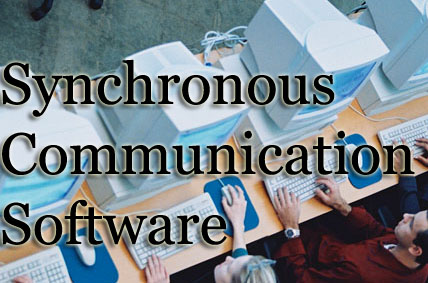 |
ETAP 529 Introduction to Distance Learning Technology Group 4: Abigail Moskovits, Tom Cutonilli, Anne Canale Stalnecker |
|---|---|
| Table of Contents > Introduction > SCS Technologies > Appropriate Uses & Limitations >Support & Costs> References | |
AIM Acronym Dictionary. Retrieved February 28, 2008, from: http://www.aim.com/acronyms.adp.
Bonk, Curtis J. (2002). Collaborative Tools for e-Learning. Retrieved February 22, 2008 from: http://www.clomedia.com/content/anmviewer.asp?a=41&print=yes
Collison, G. et al. (2000) Facilitating Online Learning: Effective Strategies for Moderators
Atwood Publishing, Madison, WI. http://www.atwoodpublishing.com/
Connor, A. (2005) "Instant Messaging: Friend or Foe of Student Writing." New Horizons for Learning. Retrieved Februar 29, 2008, from http://www.newhorizons.org/strategies/literacy/oconnor.htm.Cooze, B., and Barbour, B. Usage of Instant Messaging as a Means of Community Building in e-Learning Environments. Retrieved February 22, 2008 from: http://web.ncf.ca/an650/academic/conferences/cade-03-im_files/frame.htm
Galusha, J. M. (1998) Barriers To Learning in Distance Education. Retrieved February 23, 2008 from: http://168.144.129.112/Articles/Barriers%20to%20Learning%20in%20Distance%20Education.rtf
Garrison, D. R. and Anderson, T. (2003). E-Learning in the 21st Century. Routledge Falmer, NY.
Hiel, E. (1997). Plausible Uses and Limitations of Videoconferencing as a Tool for Achieving Technology Transfer. Journal of Extension.
Hrastinski, S. (2006). The Relationship Between Adopting a Synchronous Medium and Participation in Online Group Work: An explorative Study. Interactive Learning Environments, 14 (2), 137-152. Retrieved February 23, 2008 from http://web.ebscohost.com.libproxy.albany.edu/ehost/pdf?vid=7&hid=101&sid=cf0d3654-4e4c-414f-991f-501ee803719c%40sessionmgr106
Kleiman, G.M. (2004). Myths and realities about technology in k-12 schools: Five years later. Contemporary Issues in Technology and Teacher Education, 4(2), 248-253. 248. Retrieved February 28, 2008 from: http://www.citejournal.org/vol4/iss2/seminal/article2.cfm
Ohlund, B., et al. (1999). Impact of asynchronous and synchronous Internet-based communication on collaboration and performance among k-12 teachers. http://kolea.kcc.hawaii.edu/tcc/2003/conference/presentations/margalit2_p.html
Oren, Avigail. Communication Tools in an On Line Collaborative Assignment – Usage and Preferences. Available at http://www.eecs.kumamoto-u.ac.jp/ITHET01/proc/035.pdf
Reynard, R. (2007) Online Focus. Tips for Using Chat as an Instructional Tool. Campus Technology. Retrieved February 23, 2008 from: http://nide.snow.utoronto.ca/SyncComm/Synchronousindex.htm
Rumble, G. (2001). The Cost and Costing of Networked Learning. JALN v. 5 #2. Retrieved February 23, 2008 from: http://sloan-c.org/publications/jaln/v5n2/pdf/v5n2_rumble.pdfSherry, L. (1996). Issues in Distance Learning. International Journal of Educational Telecommunications. 1 (4), 337-365. Retrieved February 18, 2008 from: http://carbon.cudenver.edu/~lsherry/pubs/issues.html
Stahl, In G. (2002). Supporting Discourse in a Synchronous Learning
Environment: The Learning Protocol Approach. Retrieved February 23, 2008 from: http://www.fhnon.de/fbwp/pfister/inhalte/dfgprojekt/CSCL02-pfister.pdfWorley, G.G. Project-Based Learning through Global Learning Communities of K-12
Students. Retrieved February 27, 2008 from: http://homepage.mac.com/worley/global/PBL_Global.pdf*Images Anne created with Snagit screen capture software; Chat image from http://www.woize.com/help.php?topic=50; Woman on laptop from: http://www.thinkslearning.com/.
Next page > Top of Page > Table of Contents
Technology Group 4: Abigail Moskovits, Tom Cutonilli, Anne Canale Stalnecker
ETAP 529 Introduction to Distance Learning
Professor Virginia Yonkers
University at Albany
Spring 2008
Updated 02-Mar-2008